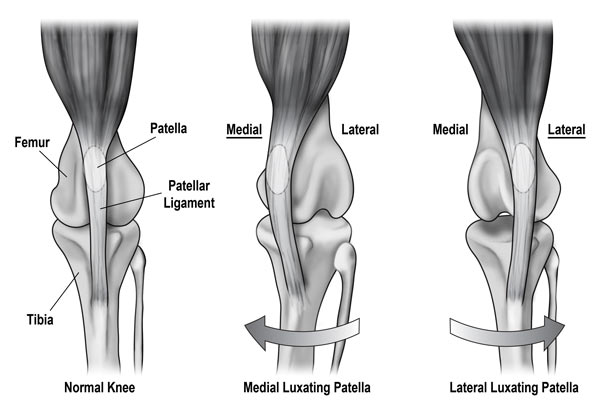Patellar luxation is one of the most common orthopedic problems in dogs. The patella, or kneecap, normally rides in a groove (trochlear groove) within the femur (thigh bone) of the knee. But in some dogs the patella can slip out of this groove, usually when the knee is flexed, causing varying degrees of lameness.
In the majority of cases, the kneecap ends up displaced toward the midline of the dog’s body. This is called medial patellar luxation. Less commonly, the kneecap is displaced toward the outside of the leg. This is called lateral patellar luxation. In about half the cases both legs are affected.
How is Patellar Luxation Diagnosed?
Your veterinarian will be able to determine by the feel of the kneecap and how much it moves. Your dog will most likely need to have X-rays completed in order to determine if they’re affected. This is typically where your vet would be able to identify if your dog’s groove is too shallow to keep the patella in place. If your dog has a more severe case (Grade 3 or 4), you may want to get multiple opinions since the grade level could determine whether your dog will need surgery.
What are the Signs of Patellar Luxation?
The most common sign is that the dog will occasionally skip, carrying its hind leg up and forward for a few steps. The dog may need to straighten or shake its leg to reset the patella in the groove, but as the condition gets worse, the skipping occurs more often and lasts longer.
Puppies with severe medial luxation may appear bow-legged; large dogs with lateral luxation may appear knock-kneed. Your veterinarian can often diagnose the condition just by feeling and manipulating the knee. More advanced imaging may help get a better idea of severity and treatment plans.
Patellar luxation is graded by severity, as follows:
Grade 1: Knee cap can be manipulated out of its groove, but returns to its normal position spontaneously
Grade 2: Knee cap rides out of its groove occasionally and can be replaced in the groove by manipulation
Grade 3: Knee cap rides out of its groove most of the time but can be replaced in the groove via manipulation
Grade 4: Knee cap rides out of its groove all the time and cannot be replaced inside the groove
What Causes Patellar Luxation?
Although occasionally trauma can cause luxation, more often the condition is considered to be at least partly hereditary. Affected dogs commonly have abnormally shallow femoral grooves. Other abnormalities in the hip, femur, tibia and even the muscles and ligaments surrounding the patella may also be involved.
Small dogs (especially Pomeranians, Chihuahuas, Boston Terriers, Yorkshire Terriers, Teacup Yorkie Poos, and Miniature Poodles) are most known as being predisposed, but large breeds such as the Chinese Shar-Pei, Flat-Coated Retriever, Akita and Great Pyrenees also seem predisposed.
See our Breed Guide for more specifics on your pet.
How is Patellar Luxation Managed?
The condition tends to get worse with age, probably because the repeated slippage wears down the sides of the groove. It also wears away cartilage and exposes areas of bone, leading to inflammation, arthritis and pain.
In mild cases, you may be able to control the condition with non-surgical treatments such as pain medications and supplements. It is imperative that you keep your dog’s weight down to minimize stress on the joint. For dogs with a Grade 2 or higher, surgical correction has a high rate of success, especially in small dogs.
Surgery includes reinforcing the lateral collateral ligaments that keep the kneecap in alignment. They also may have to deepen the trochlear groove to allow the patella to stay in place. In more serious situations where it can’t be fixed by deepening the trochlear groove, they may have to relocate the tibial attachment.
If a luxating patella in grade 2 or higher isn’t treated, there’s a high chance that it will turn into arthritis within time.






